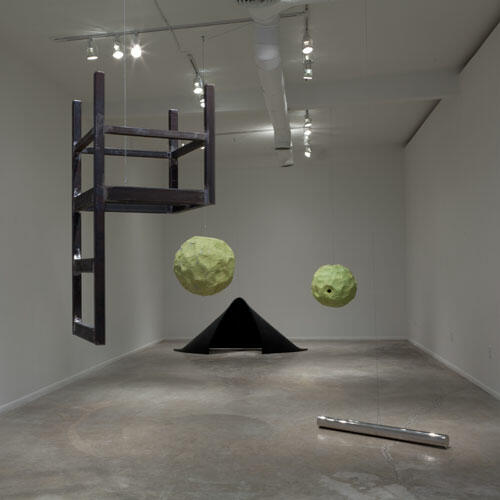Jorge Pedro Núñez
Kabe Contemporary, Miami
In the visual tissue created in Concetto spaziale, Pedro Núñez’s solo show (Caracas, 1976), the artist reflects on the experience of art from the starting point of art itself. The show − homonymous of the series of works produced by the Italian-Argentinean artist Lucio Fontana − evidences a clear formal and conceptual concern which continues the framework of reflection that Núñez has been working on, regarding authorship, the work itself and its place in history. The main installation, which gives its title to the exhibition, opposes three specimens of the re-creation of Fontana’s hole-riddled spheres with one of Bruce Nauman’s inverted chairs, Walter de Marías’s lineal meter in stainless steel and the piece To Lift by Richard Serra.

Núñez’s recent work moves away from the previous sculptures and installations in which he also replicated artists’ works, but these were made from recycled materials (vinyl records and their covers, old magazines, neons, pieces of wood, etc.), to record, rather, the reflection around the work itself and its signification, as well as the relationship which is established between the pieces and the spectator, in which the resulting assemblage forms a great fabric of spatial and historical tensions. The exercise of recreating someone else’s work (as an artist) is very interesting. To work with it, interpret it and, finally enter into a dialogue with it and confront it with the work of other artists (as a curator). Núñez does not attempt to produce a hierarchical or comparative dialogue between the pieces; instead, he brings them together creating relationships that have to do with concretely historical, conceptual and spatial problems of art itself, generated in the recent past. In this way, his main focus interest is the variety of eventual relationships that could be generated between geometric abstraction, minimalism and conceptual art. The attribute of transversally re-positioning the history of art with the present, and from various points of authorship, creates in Concetto Spaziale an intricate network that takes away the individual piece from the fetish that the original work supposes, and that causes the structures of power in the complex relations of the work with the market and the art territories to stagger.
Núñez’s work has been linked to the idea of constructing new contents with that which already exists, of reviewing the historicity of art; however, in Concetto Spaziale, he also intimately reflects on the space of/in the work, on the possible tensions with the works of other artists who have contemplated and worked with the problem of space and above all on the void, woven together with a possible comment on the saturation and the limitations of art. Not only does Núñez recreate the pieces of other artists, but he also cures the space, delimiting the dialogue between specific pieces, a practice that places him as a middleman, and that in a way erases the frontier between the artist, the curator and the history of art.
The works which serve as reference thus obtain the freedom of entering a dialogue with other spaces of reflection and of taking a position in new contexts and horizons, promoting in the spectator his questioning himself on authorship, on the spatial and rhizomatic problems of the conception and the experience of contemporary art.
-
 Photo of installation in exhibition space. Photograph: Pablo Blázquez Courtesy KaBe Contemporary, 2011. Foto instalación en sala: Fotografía: Pablo Blázquez. Cortesía KaBe Contemporary, 2011.
Photo of installation in exhibition space. Photograph: Pablo Blázquez Courtesy KaBe Contemporary, 2011. Foto instalación en sala: Fotografía: Pablo Blázquez. Cortesía KaBe Contemporary, 2011.




